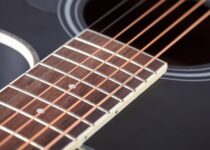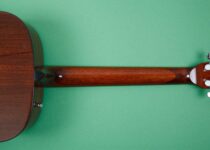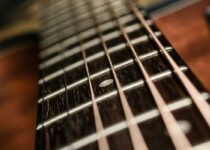Whether you already have an electric guitar or are planning to buy one, knowing your electric guitar anatomy helps you pick out the features that really matter to you. You’ll be able to connect with the instrument better and even work on it yourself.
We’ve compiled a list of all the parts of an electric guitar, including different components on various models. With this guide, if you decide to upgrade your ax or take it to a guitar technician for servicing, you’ll know all the terminology and components.
- Read More: Acoustic Guitar Anatomy
Post Contents
Electric Guitar Anatomy: The Main Parts of an Electric Guitar
While electric guitar parts can vary, here are the main ones you’re going to see on any model.
Body
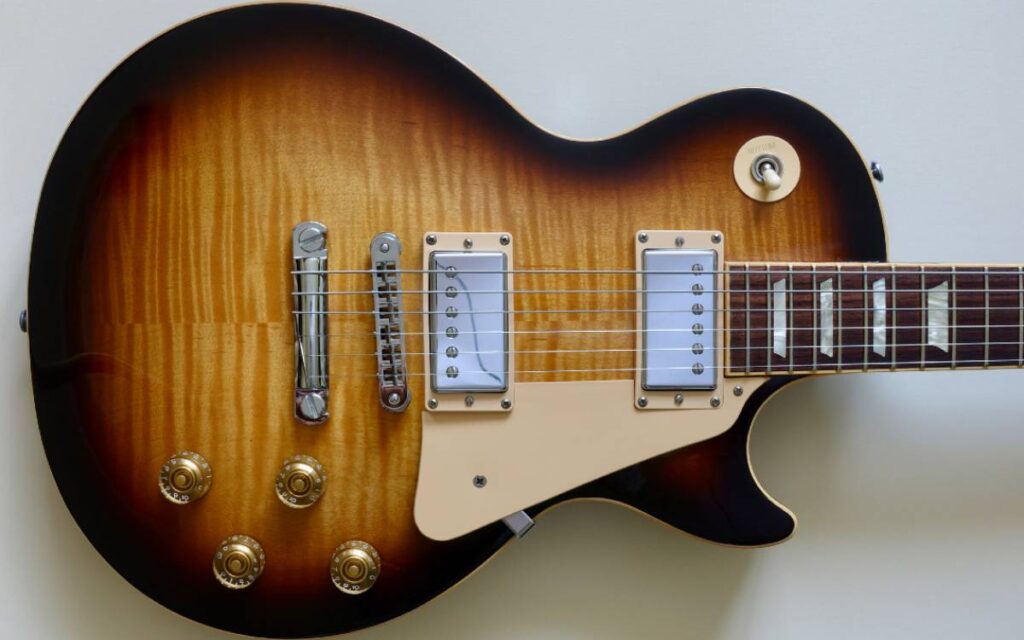
The body constitutes most of the instrument’s bulk since electric guitars are often solid-body. As the mainframe of the guitar, it plays a significant role in overall tone and harmonics.
The body of an electric guitar is usually made of wood and comes in a few basic shapes and styles. The most common body shapes are double-cut and single-cut body types. The body’s shape differs depending on the kind of guitar and the manufacturer. Aside from the standard body shapes, there are also many unique and daring guitar styles, like the V-shape or moon-shaped.
The electronics of your electric guitar are housed in the instrument’s body. Some electric guitars have ergonomic curves (we’ll talk about contours later) that make playing more comfortable because they rest snugly against your body while you play.
The wood used for the guitar body differs from one guitar to another. Whether different types of wood affect the tonal properties of an electric guitar has long been debated, but in our experience, they certainly play a role in the overall feel. Common woods for electric guitar bodies include ash, alder, mahogany, maple, and basswood.
The woods used for the body are also called ‘tonewoods’ since they affect the guitar’s tonal qualities – its harmonics, overtones, resonance, depth, and more.
The most typical of electric guitar bodies is the solid body. Semi-hollow body electric guitars have the two bouts hollowed out, often with F-holes or soundholes that allow airflow and a solid center block running through the body. As the name implies, a hollow-body guitar is entirely hollow on the inside. The first electric guitars were hollow-body guitars, similar to acoustic guitars in many ways.
Examples of solid-body guitars include the Fender Stratocaster and Gibson Les Paul, while the Gibson ES-335 is a semi-hollow body guitar. Fully hollow-bodied guitars are less common now, but the Gretsch White Falcon is an excellent example with a distinctive tone.
Each body type produces a distinct tone that contributes to the guitar’s overall sound. For a deep dive into guitar shapes, check this video:
Neck
The guitar’s neck is the piece of wood that sits between the headstock and the instrument’s body. It is located beneath the fretboard, which is glued on top. Both the guitar neck and fretboard can be made of different materials.
However, there are times when the guitar neck and fretboard are a single piece of wood, such as in some neck-thru models. The various guitar necks differ due to the wood used, but mahogany, maple, wenge, koa, and rosewood are commonly found.
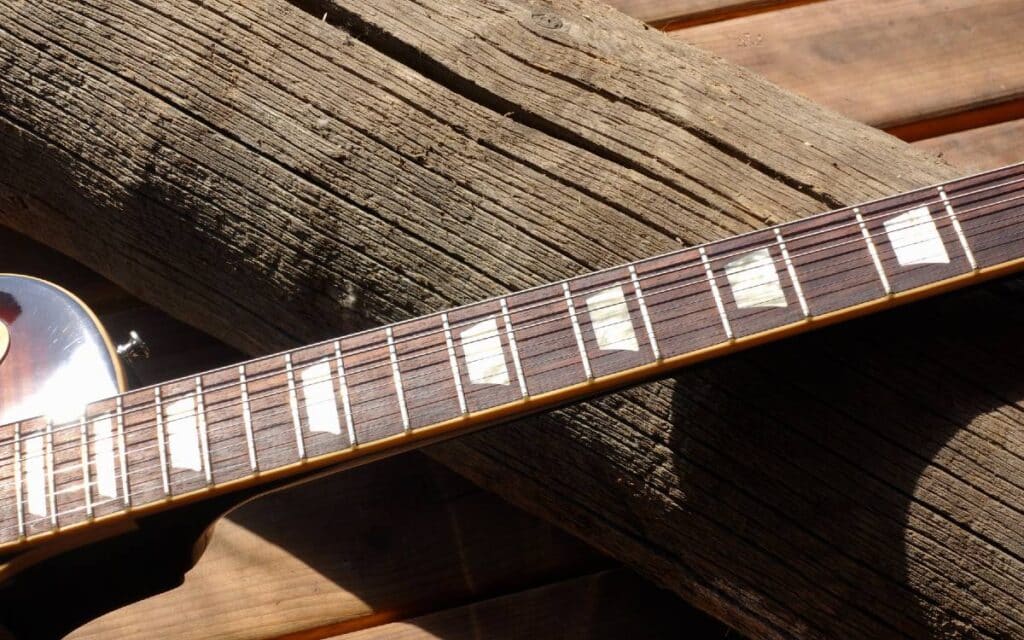
The guitar’s neck shape, also known as its’ neck profile’, is the back of the neck when viewed cross-sectionally. This doesn’t affect how the instrument sounds but instead determines the playability, left-hand comfort, and overall ergonomics. By having a neck shape that suits your hands, you can get a better feel for the guitar.
Neck profiles are classified into four broad types: C, D, U, and V because the neck shape physically resembles the shapes of the letters when viewed cross-sectionally. There is no ‘best neck shape’ because this comes down to personal preference, but the C shape is quite common. Here’s a video explaining the neck shapes in more detail.
Fretboard/Fingerboard
The fretboard, also called a fingerboard, sits just above the neck. This flat side of the neck of the guitar is where you place your fingers to play chords or notes. Players frequently overlook what the fretboard is made of, but it can significantly affect playability and comfort.
A variety of tonewoods are used to make fingerboards. The most well-known are rosewood, maple, and ebony. Whether these woods significantly affect tone is debatable, since pickups and electronics are the most crucial factor for an electric guitar’s tone.
Having a stronger, more robust fretboard like ebony has its advantages with durability, especially when using larger-sized frets or stainless steel ones.
Headstock
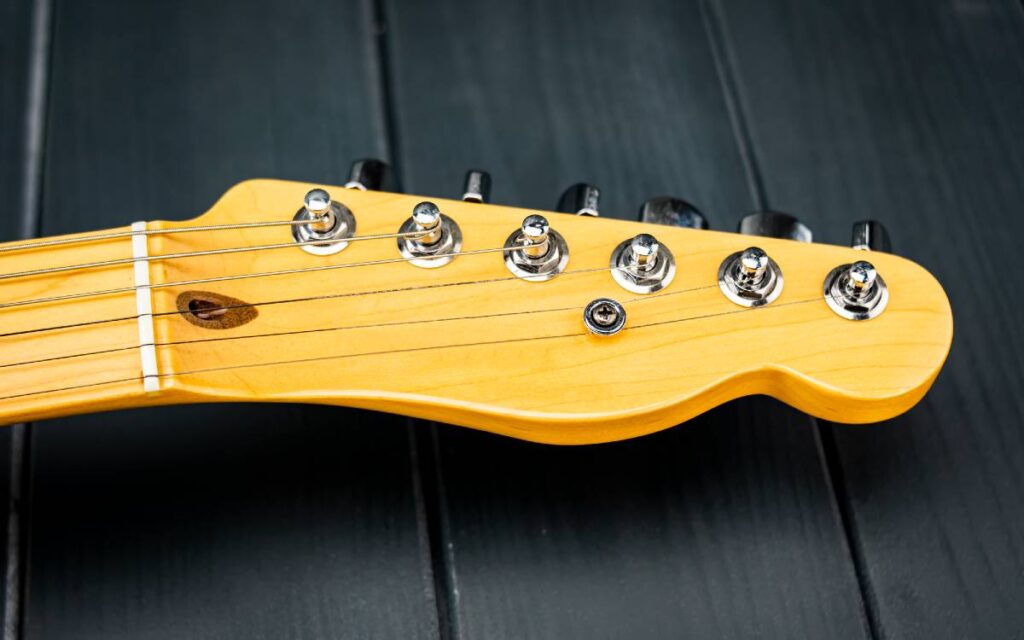
The guitar’s headstock is the top part of the guitar. It houses the nut, tuning pegs/machine heads, and truss rod cover. The primary function of the headstock is to provide a platform for tuning the strings and then to hold the strings down stably.
While the headstock used to be considered essential, some modern guitar designs are ‘headless.’ These headless electric guitars add all of the tuning machines and the nut on a much smaller area, allowing for more lightweight guitars with better ergonomics.
There are several shapes of headstocks you’re likely to see: the straight headstock is not angled in any way and is standard on Stratocasters. The curved, non-jointed headstock, also known as the tilted back headstock, forms a pronounced angle with the neck. These can be found on various guitars from Ibanez, Gibson, and other brands.
The scarf headstock is angled the same way as the tilted back headstock. The design differs in that a single straight piece of wood will be cut into two separate parts to form the neck and headstock. Some Gibson models employ this technique, which offers increased neck joint stability.
Tuning Machines
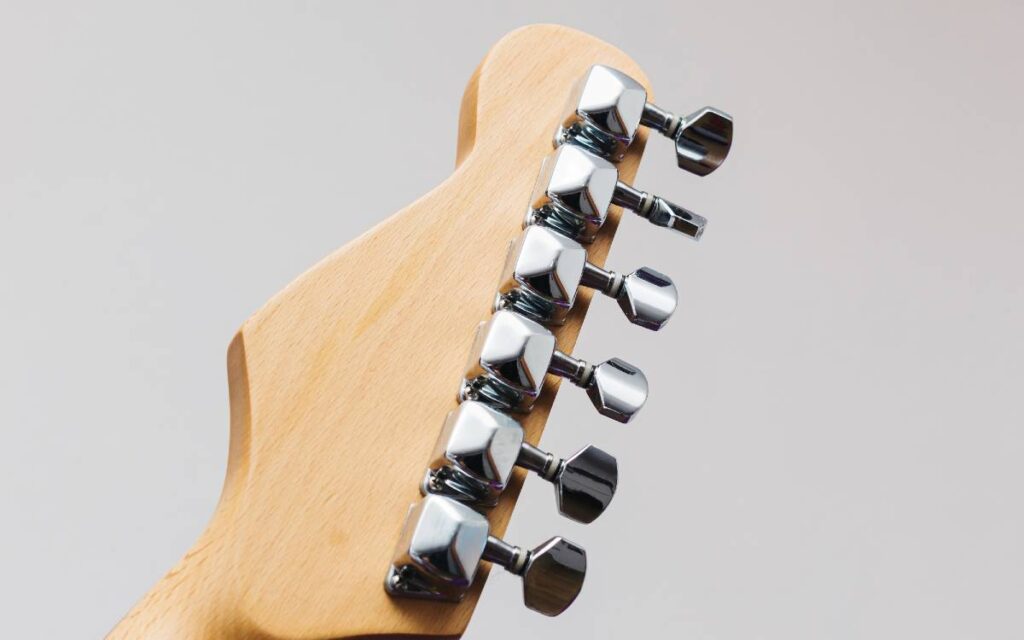
Tuners, tuning pegs, tuning heads, and gear heads are all names for the tuning machines on your guitar. They are attached to the headstock and protrude from it. They are used to adjust the pitch of the strings (by tightening or loosening them) and, most importantly, to keep the strings from slipping.
Machine heads are classified into six types: sealed, lock-in, side-mounted, vintage closed-back, vintage open-back, and staggered. But most modern guitars use sealed or locking tuners (which stop strings from slipping easily). Their positioning varies from guitar to guitar as well.
Some guitars have three tuning machines on either side (like the Les Paul), while others have six in a row (like the Strat or an Ibanez). And every now and then, you may come across a guitar with a 4 and 2. You’ll need good tuners that don’t slip to keep your guitar in tune over time.
Nut
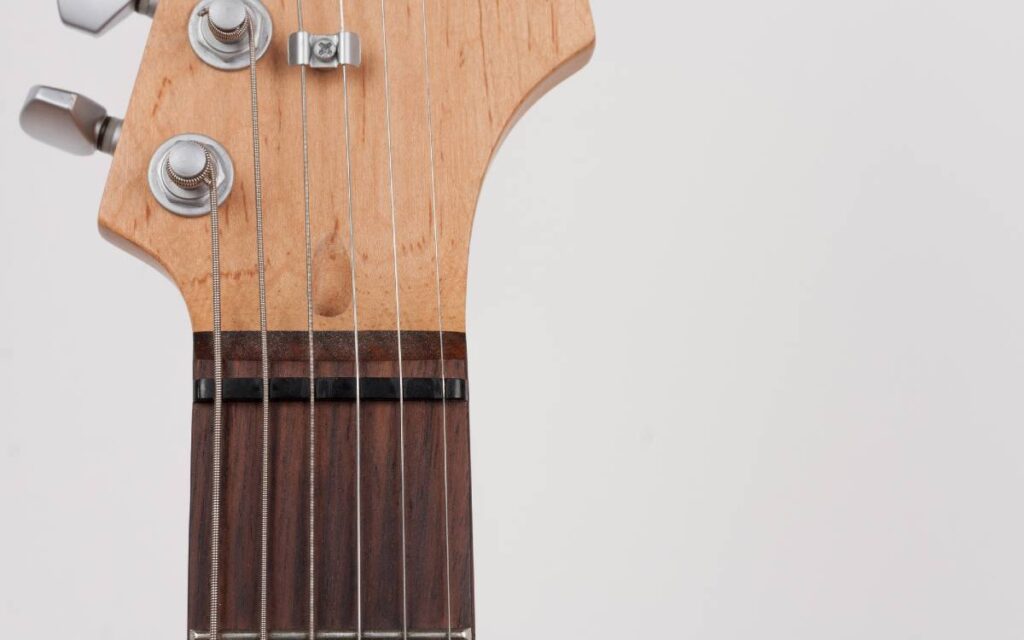
The nut is located at the joint between the neck and the headstock. The nut is the point of string contact when playing open strings. Along with the bridge and frets, it constitutes ‘the holy trinity of tone.’ These three components significantly affect the sustain and harmonics of your guitar tone.
This minor detail is often overlooked, but the material and shape of the nut can affect the overall sound and performance of your guitar, not to mention its playability. Plastic, bone, or composite material can be used to make nuts. Metal nuts, such as those used in the Floyd Rose locking tremolo system, can also be used.
Less common roller nuts can help to reduce string friction. Graphtech TUSQ nuts use a new material that helps prevent friction that can cause buzzing or string dampening. On the other side of things, a guitar nut is also someone who is utterly obsessed with guitars!
Truss Rods
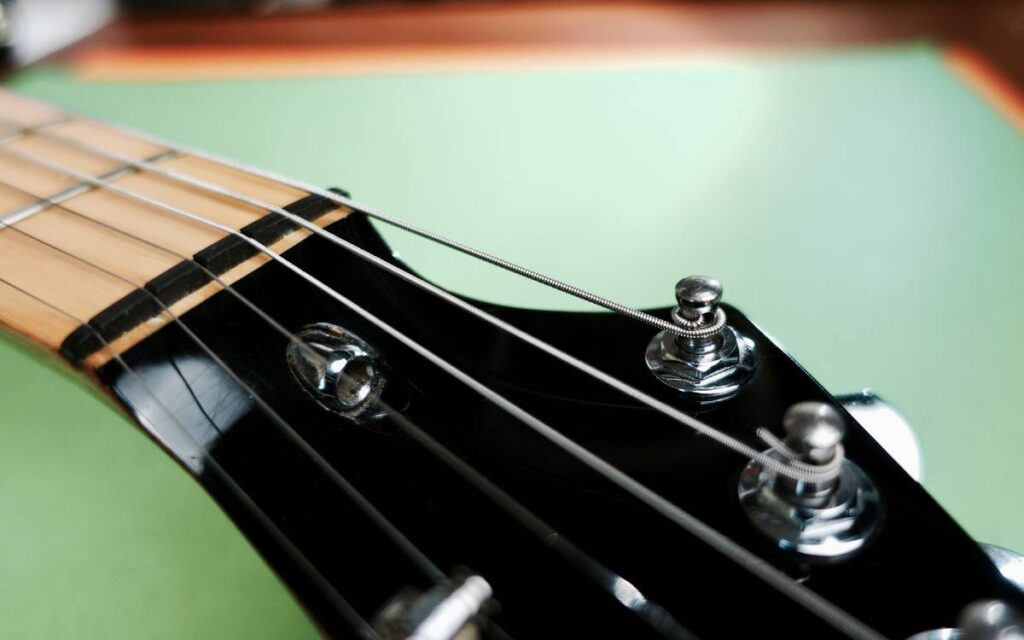
The truss rod is a metal bar that runs the length of the guitar neck. Truss rods are typically made of steel, but some can be made of other materials, such as graphite or carbon fiber. You can adjust the truss rod to help the guitar neck resist string tension.
A truss rod is installed inside the neck, under the fretboard, in a channel. If a guitar lacked a truss rod, the neck would gradually bow over time, making the action (the strings’ height over the frets) unplayable. A truss rod functions by opposing the pull of the strings.
A guitar neck’s bow can be straightened by adjusting the truss rod. You can also change the relief of the neck, which affects the guitar’s action and intonation. Correctly setting the truss rod is vital for having a well-maintained, well-setup guitar.
Truss rods in guitars are classified into two types: single-action and dual-action.
In single-action truss rods, you can change the relief of the neck by adjusting the truss rod, which affects the action and intonation of the guitar. These truss rods are limited because they are only designed to create a back bow and can’t move in the opposite direction.
Dual-action truss rods have a fixed bar that runs the length of the rod and is threaded on both sides. Dual-action truss rods can be adjusted to produce a back or forward bow, so they are more versatile. Having a forward bow can be advantageous for low-action setups.
Bridge and Saddle
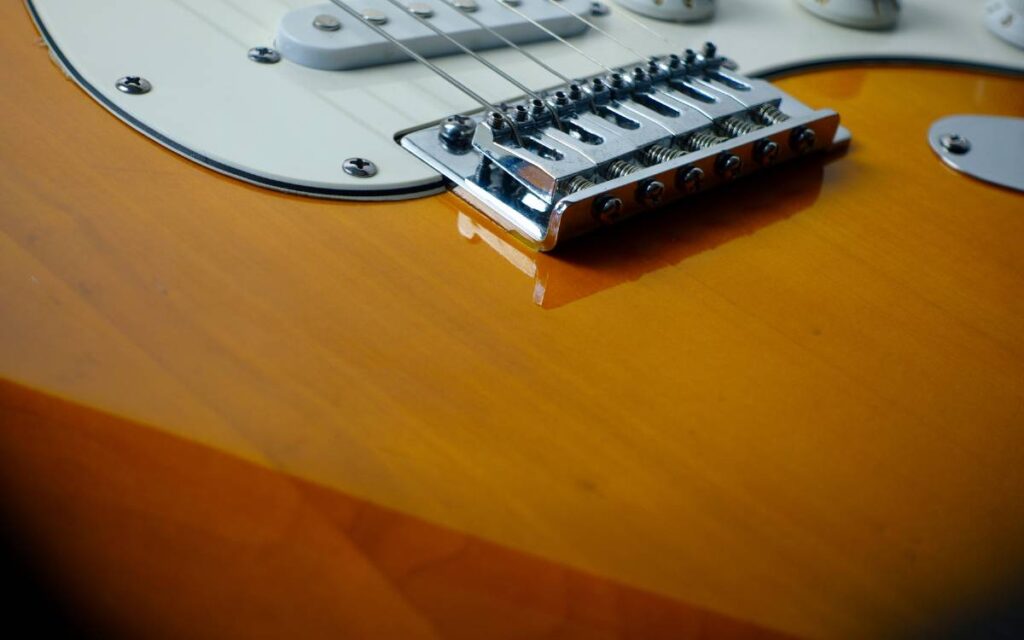
The bridge holds the string down and transfers any vibration from the string to the body’s wood. The saddle functions similarly to the nut in that it raises the strings, so they don’t touch the fingerboard unless pressed.
The distance between the nut and the saddle determines the guitar’s scale length, which affects string tension, open strings, and overall playability. Common scale lengths are 24.75″ on a Les Paul, 25.5″ on a Fender Stratocaster, and 25″ on a PRS Standard or Custom guitar.
An electric guitar’s saddle is highly adjustable. You can move each string forward or backward for better intonation (accuracy of pitch) and control the string’s height relative to the fretboard (string action).
The shapes and functions of bridges will vary depending on the company. However, most of them are simply improvements or design changes to the four main electric guitar bridges.
The fixed bridge is the most basic and easiest-to-maintain bridge. There is only a bridge and a separate saddle that can be adjusted to achieve proper intonation.
Floating tremolo bridges are commonly found on Stratocaster-style guitars or other similar models. As a result, the guitar saddle is also fixed to the bridge. The whammy bar changes the guitar’s pitch on the fly, which is useful for creating unique effects.
The Bigsby bridge, the most expensive bridge, is mostly only available on jazz or blues guitars. It operates similarly to the floating tremolo but with a fixed bridge’s bridge and saddle configuration (separate bridge and saddle).
The most intricate electric guitar bridges are the Floyd Rose tremolo. This bridge is primarily found on modern hard rock and metal guitars, such as Ibanez. This is the floating tremolo bridge on steroids.
It has the same bridge and saddle configuration as the original, but the whammy bar is what makes the difference. Instead of simply pushing it downwards like the floating tremolo, you can aggressively pull up on the whammy bar as there is a cut-out on the underside of the guitar.
Pickups

The pickup is often called the ‘heart’ of an electric guitar because it’s the primary component that picks up the strings’ vibrations and has the most significant impact on guitar tone.
Pickups make use of magnetic coils to convert string vibrations into electricity. An electric guitar pickup is a black bobbin containing six magnetic bars and a material such as enameled wire wound around the magnets. Instead of magnets, some pickups use metal rods. A long and narrow magnet is placed beneath the bobbin in this case.
In an electric guitar, steel strings serve as magnetic bodies. The frequency at which the strings vibrate affects the electric current. Higher quality pickups can pick up nuances in the sound.
Pickups for electric guitars can have one coil (single-coil pickup) or two coils (humbucking pickup). Stratocasters are more frequently seen with single-coils or a mix, while Les Pauls commonly use two humbuckers.
Although coils are susceptible to outside noise, the two coils in a humbucking pickup cancel each other’s noise (hum cancellation), which helps reduce noise. On the other hand, single-coil pickups are noisy but offer a crisp and clean high-pitched tone with a ‘twang’ to it.
As crucial as neck relief, action, and intonation are to the guitar’s playability, a pickup also must be set at the correct height for optimal sound. And remember, pickups are often the most easily upgradable part of a cheap electric guitar.
Other Components On An Electric Guitar
Since electric guitars are more flexible in design than acoustics, several smaller components vary from model to model. Here are some of the minute things you should look out for:
Neck Joints
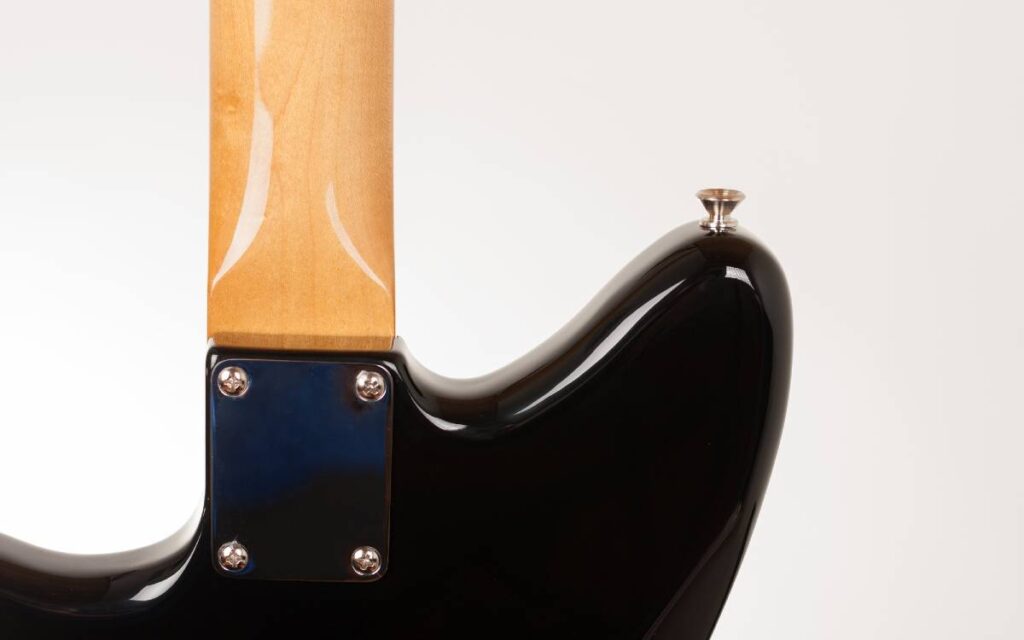
How a guitar neck is connected to a guitar body impacts tone and how the guitar feels to play. Bolt-on, set-neck, and neck-through are the three most common types of guitar neck joints.
A bolt-on neck is a screw that connects the neck to the body, and the screw is usually complemented by a metal or wood neck plate for added support and sturdiness.
In a set-neck, the neck and body are glued together rather than screwed. Unlike the bolt-on neck, a set-neck cannot be detached from the body, so a professional should do any repairs or adjustments to this type of guitar.
Neck-through necks are one piece of wood that runs through the guitar body, so instead of attaching a neck to a body, the neck is also a part of the body itself. These can help add sustain and create a sturdier body.
Pickguard/Scratchplate/Pickplate

The pickguard, also called a scratchplate or pickplate, is a piece of material, usually plastic, that is glued to the guitar’s top to protect your guitar’s finish from being scratched due to strumming. The scratchplate on many electric guitars serves a dual purpose: it covers the instrument’s electronics.
The pickguard designs vary from guitar to guitar, with Stratocasters having larger plates and Les Pauls having smaller ones. Many modern guitars do without one, but this can result in more scratches building up as you play.
Pickup Selector Switch
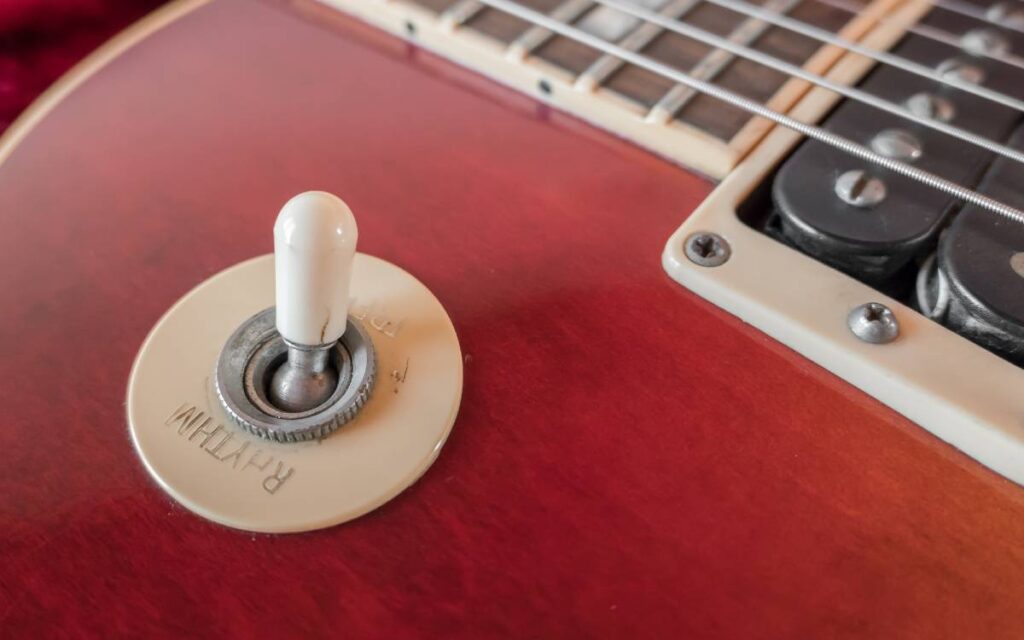
On guitars with two or more pickups, a switch allows you to select which pickup to play. Passive pickups work even when there is no power, so each pickup on a guitar will pick up sound at all times. However, only the sound from the pickup chosen with the selector will be sent to the input jack. This is because the selector alters the path of the electricity.
Pickup position has an important effect on the sound. Neck pickups have a warmer, rounded tone, while bridge pickups are bright and treble-heavy. This leads to three pickup selections: neck, middle (both), and bridge.
Some guitars have a center pickup, usually single-coil, which offers 5 or even 7 pickup configurations, depending on the manufacturer. Some guitars even allow you to “coil tap” humbuckers to make them sound like single coils.
Switches can be of two main types: a Les Paul-type switch near the top of the body, or a blade-style switch near the volume knobs, found on Stratocasters and other modern guitars like Ibanez. Which one suits you is entirely a preference, as they work similarly.
Volume and Tone Knobs/Pots
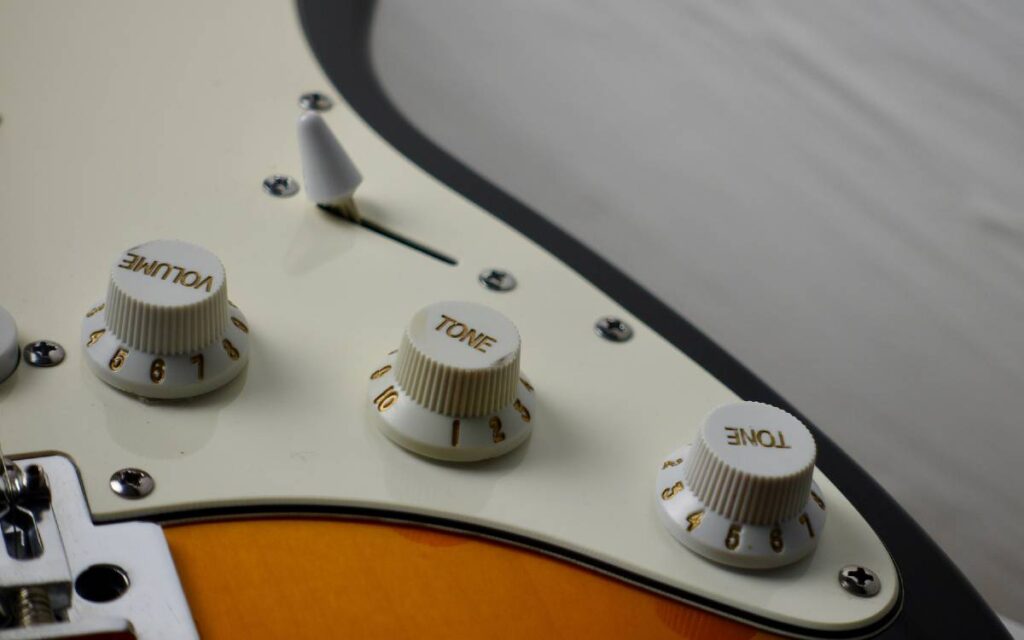
Almost all electric guitars have volume and tone controls. These consist of knobs (also called ‘pots’) that act as covers for a potentiometer inside. The pots control how the signal flows through your guitar, allowing you to reduce the gain via the volume knob.
The tone knob works via a pot and a capacitor, which can filter out high frequencies and harmonics. By rolling it off to zero, you can get a darker sound. Most knobs have markings to help indicate the level, but some don’t. A higher-quality pot will offer better electric guitar sound, tonal range, and control during live performances.
These knobs can sometimes also act as ‘switches’ for other pickup functions. For example, many humbuckers have a ‘split-coil’ mode that simulates a single-coil pickup, which can often be activated by pulling the tone knob.
Input Jack

The input jack is the connection point for your guitar cable, which can then go into an amplifier or a pedalboard. Different manufacturers use different styles of input jacks, but their essential function is the same. Just use a compatible cable: straight cables work well for Fenders, while L-shaped cables work best for Les Pauls.
Strap Pins
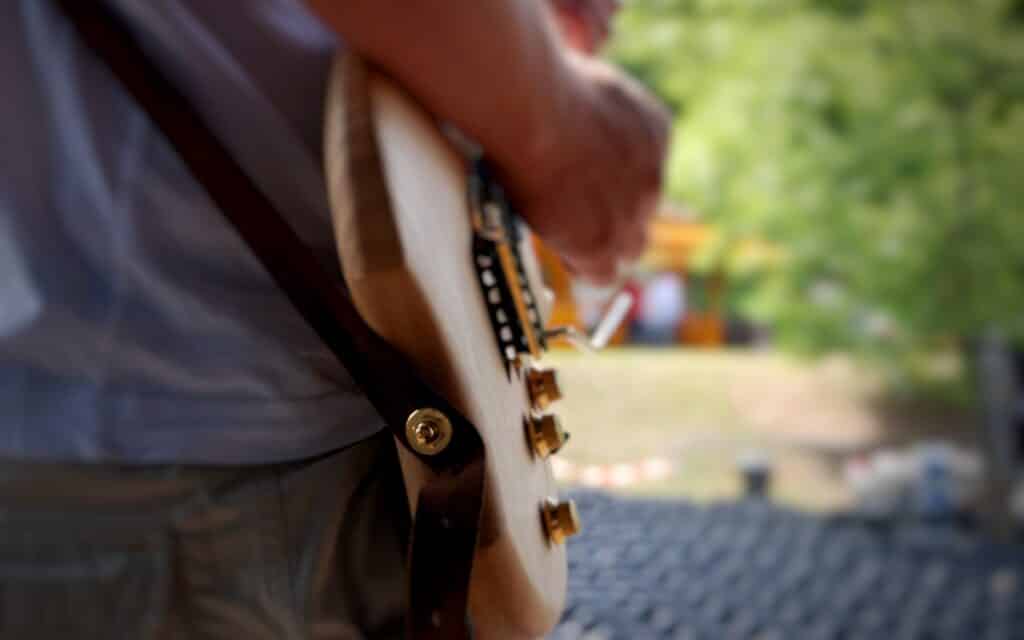
A strap pin or strap button is a wooden or synthetic handle/knob that secures a guitar strap to the heel of the instrument. A strap pin is essential because it allows you to add a strap and comfortably stand up with your guitar while playing.
Since standard strap pins are prone to ‘slipping’ from the strap, which can cause catastrophic guitar damage, a ‘locking’ strap pin is a better option. These are found on more expensive guitars, but they lock the guitar strap into place so it won’t be removed until you manually unlock it.
Cutaways/Cut-Outs
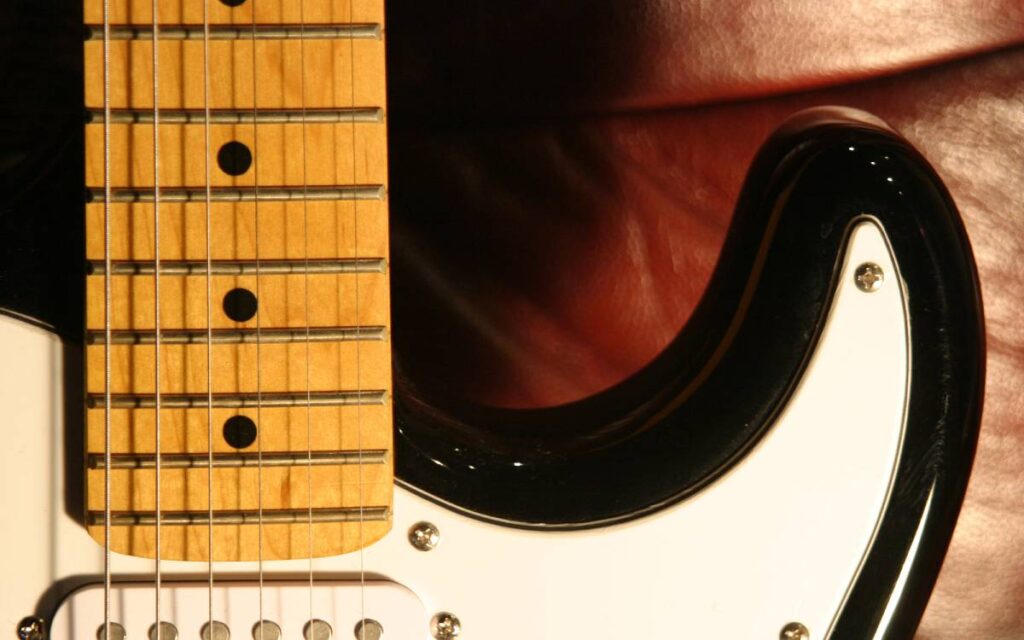
A ‘cutaway’ or a ‘cut-out’ is a chunk of wood removed from the guitar near the neck area. Cutaways make it easier for your hand to reach the higher frets. There are two types of cutaways available: single-cut and double-cut.
Double-cut guitars (such as Strats) are typically easier to play than single-cut because the additional cutaway allows your hand to glide even more easily into the higher frets. But many prefer the aesthetic and sound of a single-cut guitar (such as a Les Paul).
Contours
Contours are curved areas on the guitar’s body that offer better comfort and playability to the guitarist. Some confuse them with cutaways, but they are distinct. A contour can be made by sanding the body area to give it more smoothness. Tummy cuts and forearm cuts are the two most common contours.
String Retainer/String Tree
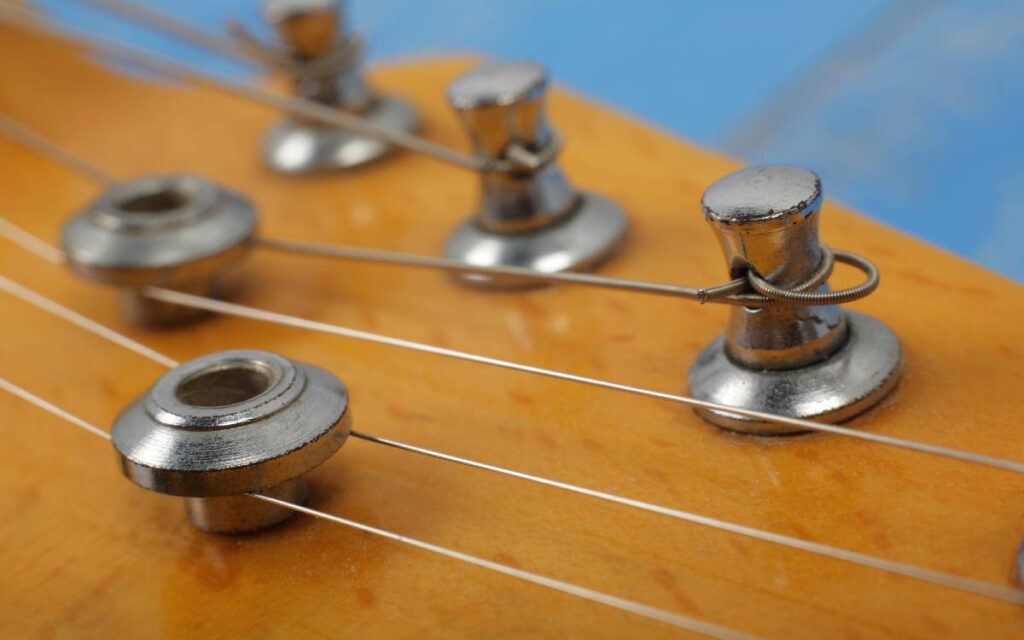
String trees are small metal widgets that attach to the guitar’s headstock. String trees are so-called because they play an essential role in stabilizing the tension of the guitar neck and securely holding the string onto the nut.
There may be some slack on the guitar strings on many headstocks as they pass over the nut and thread towards the tuning pegs. If the strings have too much slack, they will not resonate as well and may sound dull and faint, resulting in noisy overtones.
The string tree effectively secures the guitar strings to the nut. These string trees need to be positioned and angled correctly for best results and are often replaceable if there are any issues.
Skunk Stripe
A skunk stripe is a staple on Fender guitars. This refers to a dark piece of wood, typically walnut, added to Fender maple necks after the truss rod has been installed inside the channel. They don’t serve any critical function while playing guitar, but rather add to the aesthetic.
The contrast of a thin dark brown stripe against the blonde maple led to the term ‘skunk stripe’ being coined at some point. Necks with separate fingerboards such as rosewood have the truss rod installed from the front side of the neck, removing the stripe.




